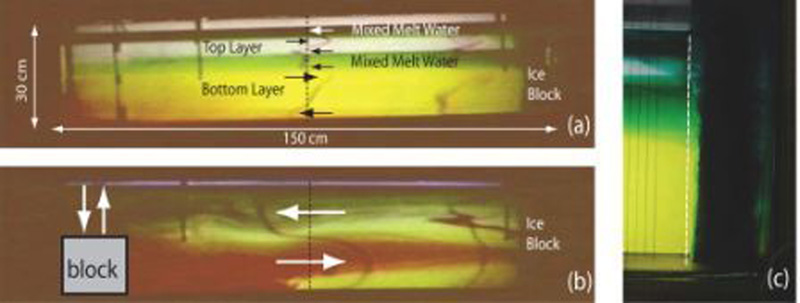Influence of fjord circulation on outlet glacier melting
Beginning in 1996, Greenland’s outlet glaciers rapidly retreated and accelerated, increasing their discharge to the ocean and contributing more noticeably than in the past to sea-level rise. The magnitude of the acceleration of these glaciers was unexpected to many glaciologists, whose numerical models of large ice sheets have variations in ice mass on millennial–timescales. Clearly, this highlights our lack of thorough understanding of the dynamics regulating the motion of glaciers. In particular, the boundary conditions regulating the interaction of glaciers with surrounding sediments, rock and water are poorly understood. As highlighted by the Intergovernmental Panel on Climate Change (IPCC) in 2007, today the largest uncertainty in predicting sea-level rise comes from the lack of a correct representation in climate models of the rapid changes observed in outlet glaciers.
Recently, a new mechanism has been identified as a possible candidate to explain the recent acceleration in glacial discharge into the ocean. Greenland’s largest outlet glaciers terminate at tidewater in deep fjords and additional heat delivered by subsurface waters may be melting the submarine bases of these glaciers. The recent warming of the ocean around southeast and western Greenland and the recently observed warm waters in Greenland’s fjords are the supporting evidence for this mechanism. This scenario highlights the possibility for the ocean to play a significant role in the recent increase of glacial discharge. Hence the need to better understand the interaction between the ocean and the ice. Several questions then arise: What is the influence of the fjord circulation on the ice-ocean interface melting rates? Can one circulation be more efficient than another in delivering the heat from the open ocean to the base of the outlet glaciers?
In order to answer these questions I am using a set of idealized laboratory experiments to investigate the efficiency of various fjord circulations in transporting heat to the outlet glaciers. Furthermore, I am investigating the influence of upstream surface meltwater coming out at the base of the glacier on the melting of the ice-ocean interface and the fjord circulation. The product of this study will be an improved understanding of the influence of: a) the fjord circulation on glacier’s melting rates; and b) the upstream basal meltwater flow and distribution in the fjord.
A first set of experiments were carried out in an insulated tank positioned in a “cold room” with Tair = 3˚C (which can be varied). The rectangular tank (L=150cm W=15cm D=30cm) is filled with a bottom layer of warmer, saltier water, and a top layer of cooler, fresher that match those observed in Sermilik Fjord (Greenland), including their depth ratio. The glacier is represented by a de-aired and dyed ice block (L=10cm W=15cm D=30cm) at one end of the tank. Two fjord circulations are reproduced as follows and compared to a control simulation with no forced flow. The estuarine circulation is generated by introducing fresh water at melting temperatures from a source at the water free surface near the ice-block. The wind driven circulation is generated by vertically displacing a solid block (L=15cm W=15cm D=15cm) at the end of the tank opposite from the ice block. The up-then-down displacement of the block drives an alternating circulation in the upper/lower layers that mimics the intermediary fjord circulation driven by wind-events. The magnitude of both circulations can be systematically varied.
The circulation pattern observed in the control experiment and in the estuarine experiment are similar to those observed by Huppert and Turner (1980) and Huppert and Josberger (1980). A thin boundary layer of rising, cold, melt water mixes with some ambient water and rises until it finds either the interface between the two layers, if in the bottom layer, or the free surface, if in the top layer (green in Figure). These results suggest that the melt water mainly deposits within the interior of the water column and not entirely at the free surface, as described in Straneo et al. (2011). In the wind-driven experiments the temperature close to the ice is warmer than for the other experiments, suggesting that this circulation is more efficient in transporting heat to the ice-block.
The targets for the laboratory experiments are:
1) Quantify the heat transport associated with different circulations and the corresponding melting rate. Preliminary results suggest that the wind driven circulation transports heat more efficiently thus enhancing melting by 50%;
2) Investigate the effect of a freshwater source at depth within the ice block simulating the summer runoff water entering the fjord (at the base of the glacier).
3) Assess the spatially variable melt rate in relation to the PW/STW interface and the resulting ice shape.
4) Evaluate where the melt water is distributed in the water column. Preliminary results suggest that the melt water is mainly redistributed in the interior and only a small fraction reaches the free surface.
5) Investigate melting rate dependence on the meltwater plume Reynolds number (Re).

Side view of the control (a) and wind (b) experiments after 2 hours from the beginning. The mixed melt water (green) circulation described in the text is visible in (a) while (b) is dominated by the motion of the solid block which has been lowered into the bottom layer. Note the larger velocities in (b) and the enhanced vertical mixing indicated by the presence of red dye higher in the water in (b) than in (a). c) Ice-water interface in (a). Dashed white line indicates the initial position of the interface. The inhomogeneous melting likely contributes to shaping the developing floating tongue.
References
Huppert, H.E., and E. G. Josberger, 1980. The melting of ice in cold stratified water. Journal of Physical Oceanography, 10, 953-960.
Huppert, H.E., and J. S. Turner, 1980. Ice Block melting into a salinity gradient. J. Fluid Mech., 100, 367–384.
Straneo, F., R. Curry, D.A. Sutherland, G. Hamilton, C. Cenedese, K. Våge, and L.A. Stearns, 2011. Impact of fjord dynamics and glacial run-off on the circulation near Helheim Glacier. Nature Geoscience, in press.